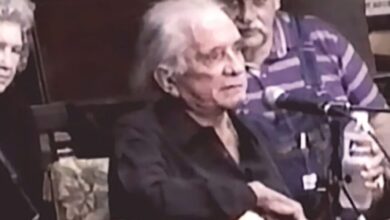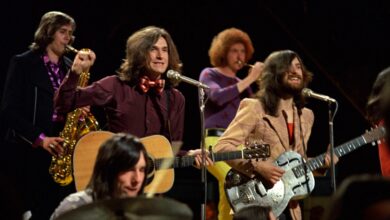Lou Christie’s “Lightnin’ Strikes” Electrifies the Charts and Reinvents Pop Drama in 1966
When “Lightnin’ Strikes” hit the airwaves in late 1965, it didn’t just chart—it exploded. By February 1966, the song had soared to No. 1 on the Billboard Hot 100, instantly becoming Lou Christie’s signature hit and one of the decade’s most distinct pop recordings. With its unpredictable structure, thunderclap vocal shifts, and dramatic storyline of conflicted young love, “Lightnin’ Strikes” stood out in a crowded field of British Invasion rockers and Motown soulsters. Its commercial success and sonic daring proved that American pop still had bold voices and new stories to tell—even in a time of massive musical upheaval.
Lou Christie, born Lugee Alfredo Giovanni Sacco in Glenwillard, Pennsylvania, had already tasted fame by the time “Lightnin’ Strikes” reached the top of the charts. His 1963 single “Two Faces Have I” showcased his remarkable falsetto and earned him a Top 10 hit. But Christie wasn’t just a singer—he was a songwriter, performer, and pop dramatist. With a voice that could climb to an emotional peak in seconds, and a flair for theatrical storytelling, Christie brought something raw and human to a genre often criticized for polish over passion.
The idea for “Lightnin’ Strikes” came from Christie’s longtime collaborator and songwriting partner, Twyla Herbert. A classically trained pianist nearly 30 years his senior, Herbert and Christie formed one of the most unusual yet effective duos in pop. Inspired by themes of temptation, commitment, and romantic chaos, the song tells the story of a young man caught between love and lust—pleading for his girlfriend’s patience while admitting he still chases other women. The “lightning” metaphor isn’t subtle, but it’s visceral. Christie, with his shifting vocal registers, makes the internal conflict sound like an emotional storm.
The recording of “Lightnin’ Strikes” took place at Olmstead Studios in New York City, with Charlie Calello—fresh off arranging hits for Frankie Valli and The Four Seasons—handling production duties. Calello’s influence can be heard in the dramatic strings, abrupt tempo changes, and layered backing vocals. But unlike the controlled sheen of a Four Seasons hit, “Lightnin’ Strikes” feels intentionally unhinged. Christie shifts from conversational baritone to falsetto shriek in seconds, mirroring the song’s emotional instability. The final touch? A church bell chime that rings out just before the chorus hits, as if to announce the arrival of chaos.
Upon release in December 1965, the single began climbing the charts rapidly. By February 1966, it had reached No. 1 on the Billboard Hot 100, displacing Simon & Garfunkel’s “The Sounds of Silence.” It also hit No. 1 in Canada and became a Top 20 hit in the UK and Australia. The song’s blend of pop, drama, and soul made it hard to categorize—but even harder to ignore. It spent 14 weeks on the U.S. charts and eventually sold over one million copies, earning a gold disc. For Christie, it was the commercial high point of his career.
The impact of “Lightnin’ Strikes” went beyond sales. It helped shift perceptions of what a male pop vocalist could do. Christie’s falsetto wasn’t just a gimmick—it was a storytelling device, capable of conveying vulnerability, confusion, and explosive desire. The song’s unusual structure—swapping between spoken sections, choral backing, and sudden outbursts—defied radio conventions. Yet it still worked. Its raw theatricality would go on to influence glam rockers like Freddie Mercury and pop experimentalists like Todd Rundgren, who admired its fearless melodrama.
With the success of “Lightnin’ Strikes,” Christie embarked on a whirlwind of national TV appearances, including American Bandstand, Shindig!, and Hullabaloo. The song became a staple of his live performances, though its challenging vocal range made it a tough act to follow. Still, Christie embraced his role as pop’s emotional daredevil, and the single’s success gave him leverage to explore more adventurous material—something he would lean into on his later MGM recordings like “Rhapsody in the Rain.”
The song also marked a shift in pop lyricism. While many songs of the era depicted clean-cut romances or dreamy heartbreak, “Lightnin’ Strikes” addressed the murky gray areas of fidelity and impulse. It wasn’t exactly a confession or an apology—it was a plea for understanding from a man who couldn’t yet tame his desires. That level of emotional complexity—wrapped in a pop package—was rare for its time and would later become more common in 1970s singer-songwriter and soft rock ballads.
Over the years, “Lightnin’ Strikes” has been covered by various artists, including Del Shannon, Klaus Nomi, and more recently, Chris Isaak. Each version brings its own twist, but none capture the unfiltered intensity of Christie’s original. Perhaps most famously, the song inspired a nod from Bruce Springsteen, who admired its blend of innocence and fire. In interviews, Springsteen cited Christie’s ability to pour heart and heat into a three-minute song as a model for his own early work.
The timing of “Lightnin’ Strikes” was fortuitous and fateful. Released just as American pop was facing an identity crisis in the face of the British Invasion, the song stood its ground. It didn’t borrow from the Merseybeat sound or try to imitate Motown. Instead, it leaned into its own unique DNA—part doo-wop, part teen drama, part operatic confession. It reminded the industry that the American pop scene still had its own original voices to celebrate.
As the years passed, Christie would continue to record and perform, but nothing would quite match the impact of “Lightnin’ Strikes.” The song has remained a favorite on oldies stations, frequently appearing on best-of-the-’60s compilations and retrospective charts. In 2004, it was ranked among Rolling Stone’s list of the 500 Greatest Songs of All Time—an acknowledgment of its lasting influence and singular sound.
Musically, the track also helped normalize bold production shifts within a single song. Its mix of spoken word, traditional verse-chorus, and unpredictable falsetto outbursts challenged producers and arrangers to think outside the box. In many ways, it anticipated the theatrical excesses of 1970s pop and rock—from Meat Loaf to Queen—and encouraged a generation of vocalists to explore emotional extremes.
Lou Christie never faded completely from the public eye. He toured steadily, recorded intermittently, and maintained a devoted fan base. His dramatic flair and vocal style have earned him a cult status that has only grown over time. He’s been honored by fellow artists, featured in documentaries, and praised in liner notes and retrospectives as one of the boldest voices of his generation.
In the final analysis, “Lightnin’ Strikes” is more than a chart-topping single—it’s a masterclass in pop expressionism. It took a risk with structure, tone, and delivery, and it paid off spectacularly. Christie captured the sound of youthful chaos, of love both irresistible and impossible to contain. Decades later, that lightning still strikes—loud, wild, and unforgettable.



